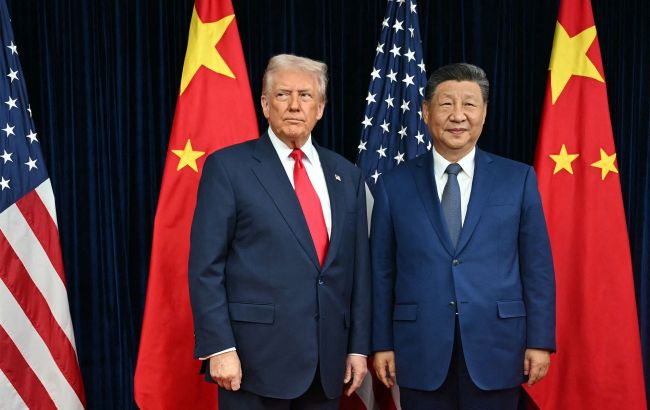'Talked about Ukraine for a long time': Key takeaways from Trump-Xi meeting
 Photo: US President Donald Trump and Chinese leader Xi Jinping (Getty Images)
Photo: US President Donald Trump and Chinese leader Xi Jinping (Getty Images)
US President Donald Trump and Chinese leader Xi Jinping held a meeting in the South Korean city of Busan. They announced a consensus and agreed to continue dialogue on resolving the war in Ukraine.
RBC-Ukraine outlines the main takeaways from the leaders’ meeting below.
Key points
- The Busan talks lasted 1 hour and 40 minutes.
- Ahead of the summit, Trump ordered the Pentagon to begin nuclear tests.
- The sides reached a consensus on trade matters. Trump agreed to reduce tariffs on Chinese goods from 57% to 47% under a one-year deal.
- In response, China will resume purchases of American soybeans, guarantee rare earth exports, and strengthen efforts against fentanyl.
- According to Trump, China will begin buying US energy, including oil and gas from Alaska.
- Trump rated the meeting “12 out of 10” and said there is huge mutual respect between the countries.
- The leaders also discussed Russia’s war in Ukraine at length and agreed to explore possible paths for resolution.
- Taiwan was not discussed. Despite expectations, both leaders ignored questions about the island’s independence.
This was the first meeting since Trump returned to the White House. The two leaders had not met in person since 2019.
Before the meeting, during which delegations sat across from each other at the negotiating table, Trump suggested discussions could last three or four hours. However, the leaders concluded talks after 1 hour and 40 minutes.
After the negotiations, Trump and Xi did not hold a joint press conference. The US president left South Korea for Washington, while Xi continued participating in the APEC (Asia-Pacific Economic Cooperation) summit.
A few minutes before meeting his Chinese counterpart, Trump posted on his social media platform TruthSocial that he had ordered the Pentagon to “immediately” begin nuclear tests because “other countries are doing it.”
He did not answer a reporter’s question about this decision when he and Xi began the summit.
Trade consensus
After the meeting, Xi told Chinese state media that he and Trump had reached a “consensus” on trade issues.
According to him, both sides should “complete further work as soon as possible, maintain and implement the agreements reached, and deliver tangible results to ease concerns about the economies of China, the US, and the world.”
Xi emphasized that China and the US should “stay on the right path” and “be partners and friends,” as well as “work together to achieve even greater and concrete results for the benefit of our two countries and the world.”
As The Guardian reports, the consensus Xi mentioned at the meeting had actually been reached by US and Chinese trade negotiation teams, who met last Sunday in Kuala Lumpur. After that meeting, the sides developed a framework for agreements, including on TikTok.
Meanwhile, Trump called the talks “truly great” on TruthSocial. He said there is enormous mutual respect between the countries, which will only grow stronger after the meeting.
After negotiations with Xi, Trump agreed to reduce tariffs on Chinese goods from 57% to 47%.
This decision was made under a one-year agreement in exchange for China resuming US soybean purchases, ensuring uninterrupted rare earth exports, and combating illegal fentanyl trafficking.
China agrees to buy US energy
Overall, Trump rated the meeting with the Chinese president 12 out of 10 and said they "agreed on many things."
“Very significantly, China has strongly stated that they will work diligently with us to stop the flow of fentanyl into our country. They will help us end the fentanyl crisis,” Trump wrote.
According to the White House chief, China agreed to begin purchasing US energy. In fact, a large-scale purchase of oil and gas from the state of Alaska could take place, Trump added.
Talked a lot about Ukraine
Trump said they discussed a possible resolution to Russia’s war in Ukraine, though oil was not particularly discussed.
“We're both going to work together to see if we can get something done. We agree that the sides are locked in and fighting, and sometimes you have to let them fight, I guess. Crazy,” Trump told reporters.
According to him, Xi plans to help the US end the war, but “there’s a lot we cannot do.”
“He's [Beijing] been buying oil from Russia for a long time. It takes care of a big part of China. You know, I can say India's been very good on that front, but we didn't discuss the oil. We discussed working together to see if we could get that war finished,” Trump said.
The US president said he does not like seeing thousands of young people, mostly soldiers, dying in war. He noted that the war does not concern the US, and on the contrary, the country even profits, but money does not matter in this case, he added.
Trump emphasized that the US supplies weapons to NATO countries, which buy them at market price and then transfer them, mostly to Ukraine. He added that the parties discussed this and agreed to work together to try to resolve the Russia-Ukraine war.
Taiwan was not discussed
It was expected that the leaders might raise the Taiwan issue. Western media reported that Beijing expects Washington to confirm the One China policy and refrain from supporting the island’s independence.
Yet, according to Trump, Taiwan was not discussed. Both leaders ignored a journalist’s question about the island’s independence amid fears in Taipei that Trump might be willing to make concessions to China (Beijing considers Taiwan its territory).
In 2025, the US raised tariffs on Chinese imports several times to 145%, and China responded with countermeasures - tariffs on US goods reached 125%.
In May, a 90-day suspension of additional tariffs was reached: the US lowered its tariffs to 30%, and China to 10%.
Ahead of the meeting, both sides exchanged tough economic measures: Beijing announced strict controls on rare earth exports, and Trump announced an additional 100% tariff on Chinese goods, raising the overall level to 130%.
Sources: CNN, Bloomberg, BBC, The Guardian, Chinese state media.

